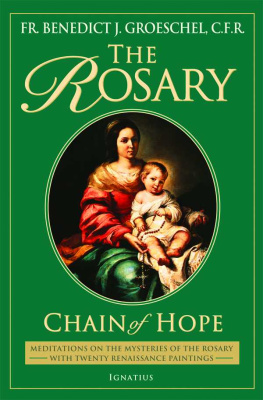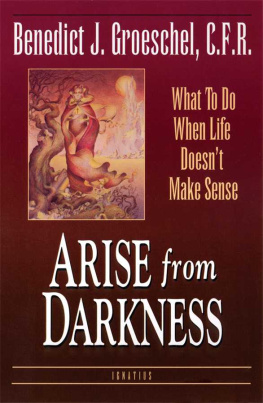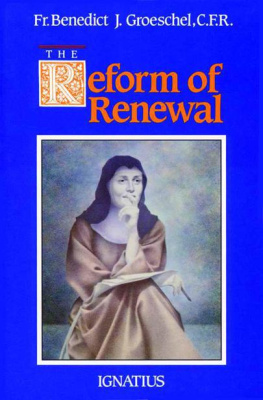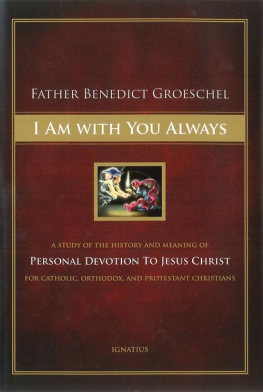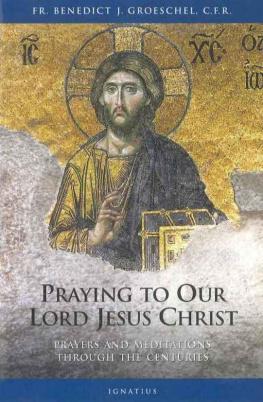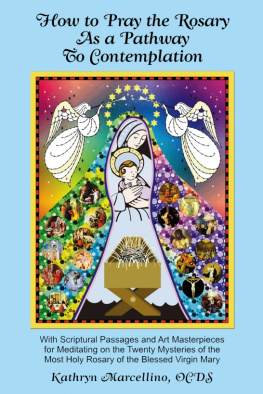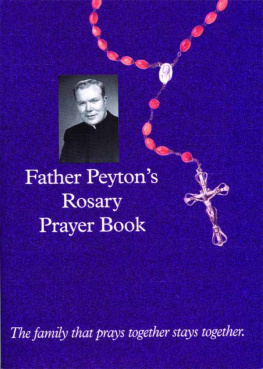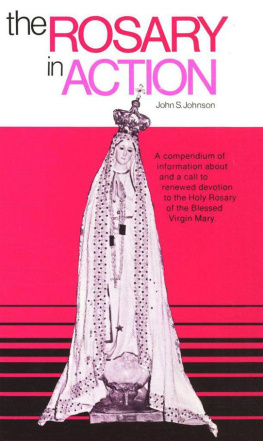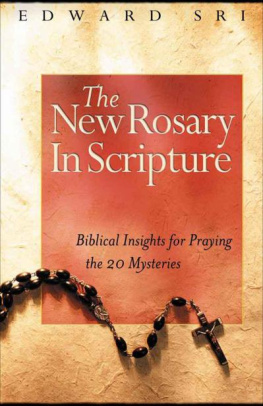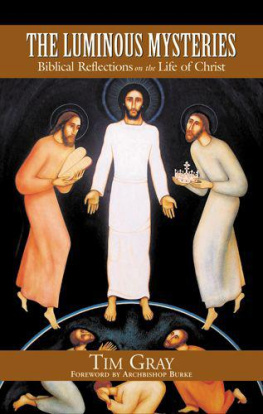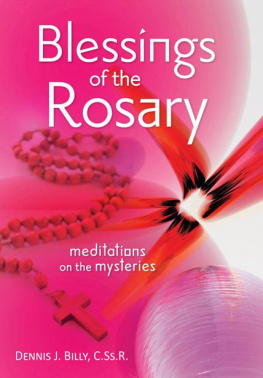THE ROSARY: CHAIN OF HOPE
FATHER BENEDICT J. GROESCHEL, C.F.R.
THE ROSARY
Chain of Hope
IGNATIUS PRESS SAN FRANCISCO
Cover art: Bartolomeo Esteban Murillo (1618-1682)
Madonna of the Rosary
Palazzo Pitti, Florence, Italy
Photograph by Scala / Art Resource
Cover design by Riz Boncan Marsella
2003 Ignatius Press
All rights reserved
ISBN 978-0-89870-983-4
Library of Congress Control Number 2003102544
Printed in the United States of America
To Our Blessed Lady,
who is always there for us
in our hours of need
Contents
Acknowledgments
I am deeply grateful to my faithful editor and friend Charles Pendergast for helping me get this little book done in a very short time. The staff at Ignatius Press, especially Tony Ryan and Eva Muntean, have, as always, been most helpful and efficient. May God bless them all.
Father Benedict J. Groeschel, C.F.R.
Feast of the Annunciation 2003
Art Credits
Cover: Bartolomeo Esteban Murillo (1618-1682), Madonna of the Rosary ,
Palazzo Pitti, Florence, Italy. Photo credit: Scala / Art Resource.
THE JOYFUL MYSTERIES
1. Carl Bloch, The Annunciation . Copyright: Frederiksborg Museum, Germany. U.S. Agent: Hope Gallery (www.hopegallery.com).
2. Carl Bloch, The Visitation . Copyright: Frederiksborg Museum, Germany. U.S. Agent: Hope Gallery.
3. Carl Bloch, The Manger Scene . Copyright: Frederiksborg Museum, Germany. U.S. Agent: Hope Gallery.
4. Simon Vouet (1590-1649), The Presentation at the Temple . Louvre, Paris, France. Photo credit: Giraudon / Art Resource, N.Y
5. Bartolomeo Manfredi (1582after 1622), Christ with the Doctors . Scala, Uffizi, Florence, Italy. Photo credit: Art Resource, N.Y.
THE SORROWFUL MYSTERIES
1. Jacopo Robusti Tintoretto (1518-1594), Christ in the Garden of Gethsemane . S. Stefano, Venice, Italy. Photo credit: Cameraphoto / Art Resource, N.Y.
2. Ludovico Carracci (1555-1619), The Flagellation of Christ . Muse de la Chartreuse, Douai, France. Photo credit: Giraudon / Art Resource, N.Y.
3. Paolo Caliari, Christ Mocked . Veronese, 16th Century. Christies Images / CORBIS.
4. Caravaggio [Michelangelo Merisi] (1573-1610), Christ Carrying the Cross . Kunsthistorisches Museum, Vienna, Austria. Photo credit: Erich Lessing / Art Resource, N.Y.
5. Diego Rodriguez Velazquez (1599-1660), The Crucifixion . Museo del Prado, Madrid, Spain. Photo credit: Erich Lessing / Art Resource, N.Y.
THE GLORIOUS MYSTERIES
1. Carl Bloch, The Resurection . Copyright: Frederiksborg Museum, Germany. U.S. Agent: Hope Gallery.
2. Jacopo Robusti Tintoretto, Ascension of Christ (1579-1580). Scuola Grande di S. Rocco, Italy. Photo credit: Cameraphoto / Art Resource, N.Y.
3. Mirabello Cavalori (c. 1515after 1572), Pentecost . Badia Fiorentina, Florence, Italy. Photo credit: Scala / Art Resource, N.Y
4. Paolo Veronese (1528-1588), Assumption of the Virgin . Muse des Beaux-Arts, Dijon, France. Photo credit: Erich Lessing / Art Resource, N.Y.
5. Diego Rodriguez Velazquez (1599-1660), The Coronation of the Virgin . Museo del Prado, Madrid, Spain. Photo credit: Erich Lessing / Art Resource, N.Y.
THE LUMINOUS MYSTERIES
1. Paolo Veronese (1528-1588), Baptism of Christ . Palazzo Pitti, Florence, Italy. Photo credit: Scala / Art Resource, N.Y!
2. Palma Giovane (1548-1628), The Wedding at Cana . S. Giacomo dell Orio, Venice, Italy. Photo credit: Cameraphoto / Art Resource, N.Y!
3. Jean-Baptiste de Champaigne (1631-1684), Sermon on the Mount . Muse Magnin, Dijon, France. Photo credit: Reunion des Muses Natio-naux / Art Resource, N.Y.
4. Raphael (1483-1520), detail from the Transfiguration . Pinacoteca, Vatican Museums, Vatican State. Photo credit: Scala / Art Resource, N.Y.
5. Juan de Juanes (1510-1579), The Last Supper . Museo del Prado, Madrid, Spain. Photo credit: Scala / Art Resource, N.Y.
CHAPTER ONE
The Rosary in Our Time
I n the fall of 2002 the Catholic world, and even the secular media, all expressed a delightful surprise and enthusiasm when Pope John Paul II announced five new mysteries that can be used in the Rosary. The front pages of newspapers, some of them addicted to celebrating the moral failings of a small percentage of the clergy, seemed for a moment to forget their general hostility to the Catholic Church. They printed stories announcing this new document, and evening TV news programs also carried the story. The media attention was somewhat surprising, because the news was of interest principally to devout Catholics, a segment of the population usually ignored by the media. Despite the predictions of some who are hostile to almost all devotion, especially Marian devotion, the Rosary could still command a great deal of attention.
Although many people are devoted to this ancient form of prayer, which is somewhat paralleled by the use of prayer beads in many other religions, the Rosary does not enjoy the universal popularity it had before Vatican II. I recall a sad Friday afternoon in November, nearly forty years ago, when I stood with the entire student body in the quadrangle of a Catholic college as we recited the Rosary for the dead President, shot in Dallas minutes before. I noticed that at least two-thirds of the students, all neatly dressed in suits and ties, had a Rosary in their hands. That was an age when your mother asked you if you had your Rosary in your pocket when you left the house in the morning. Another world.
Yet many people, young and old, are still devoted to the Rosary as a prayer of meditation and thanksgiving. Many will still say the Rosary in time of special need. Pope John Paul IIs example and personal devotion to Our Lady and the recitation of the Rosary have encouraged many to pray this prayer.
Why Repetitive Prayer ?
Years ago when the Rosary was often mumbled at wakes, our non-Catholic friends and relatives became more and more convinced that Catholicism was indeed a mysterious religion. At times it was almost impossible to understand the Rosary recited in this way. Only for this reason was I relieved when other prayers, more easily understood, were used to remember the dead and commend them to Gods merciful love.
Protestants, especially Episcopalians and Presbyterians, were used to beautiful prayers said in beautiful ways. Methodists and Baptists were accustomed to prayers said with lots of soul and feeling. They were all confused by the rapid-fire recitation of the Rosary. They were puzzled not so much that the prayers were largely directed to Christs Mother, but that this perfunctory monotone recitation would be directed to anyone at all.
Part of the problem for them was that repetitive prayer, which is an ancient practice of almost every world religion, forms no part of Protestantism. Not only prayer beads but also mantrasthat is, repeated phrasesand chants are part of much religious practice, the Protestant tradition excepted. How many times did Our Lord Himself repeat the Shema (Deut 6:4) and other phrases that are part of Jewish worship? He Himself left us a short and most profound prayer that is endlessly repeated by all Christians. In fact, that prayer is part of the Rosary.
The whole idea of repeating prayers and chants is to leave the mind free to ascend to Godto express interiorly feelings, sentiments, and ideas that are almost impossible to put into words, either because the individual does not know the precise theological phrases or, more likely, because the thoughts are so personal that they go beyond verbal expression. It is little recognized that many of the inner events of our psychic lives, especially emotions like joy, sorrow, love, anger, and fear, are not expressed in words, or, if they are, the words are inadequate. When we repeat certain phrases and even actions, like fingering prayer beads, we are invited to prayer and interior recollection, even in very disturbing circumstances.
Next page
